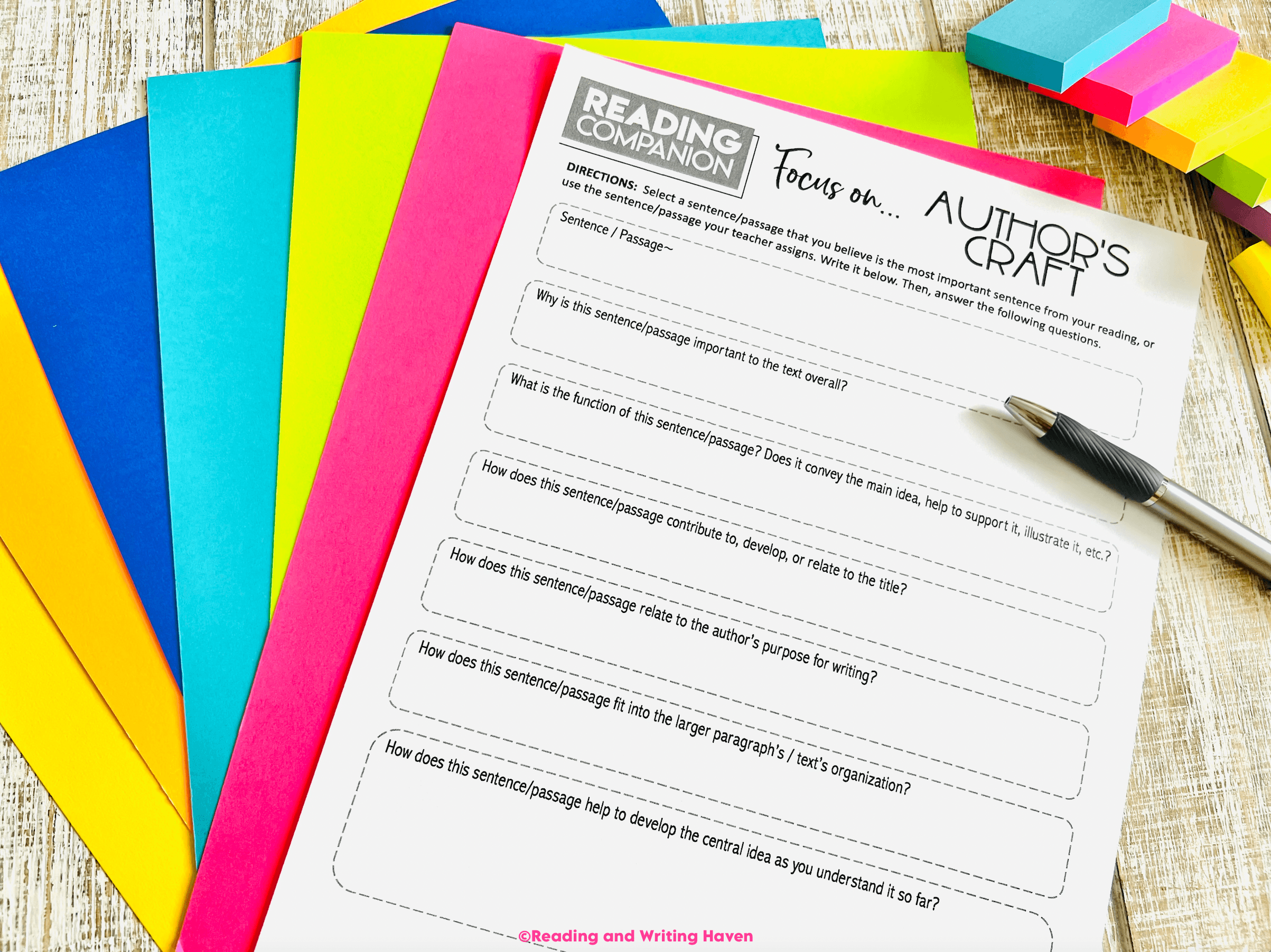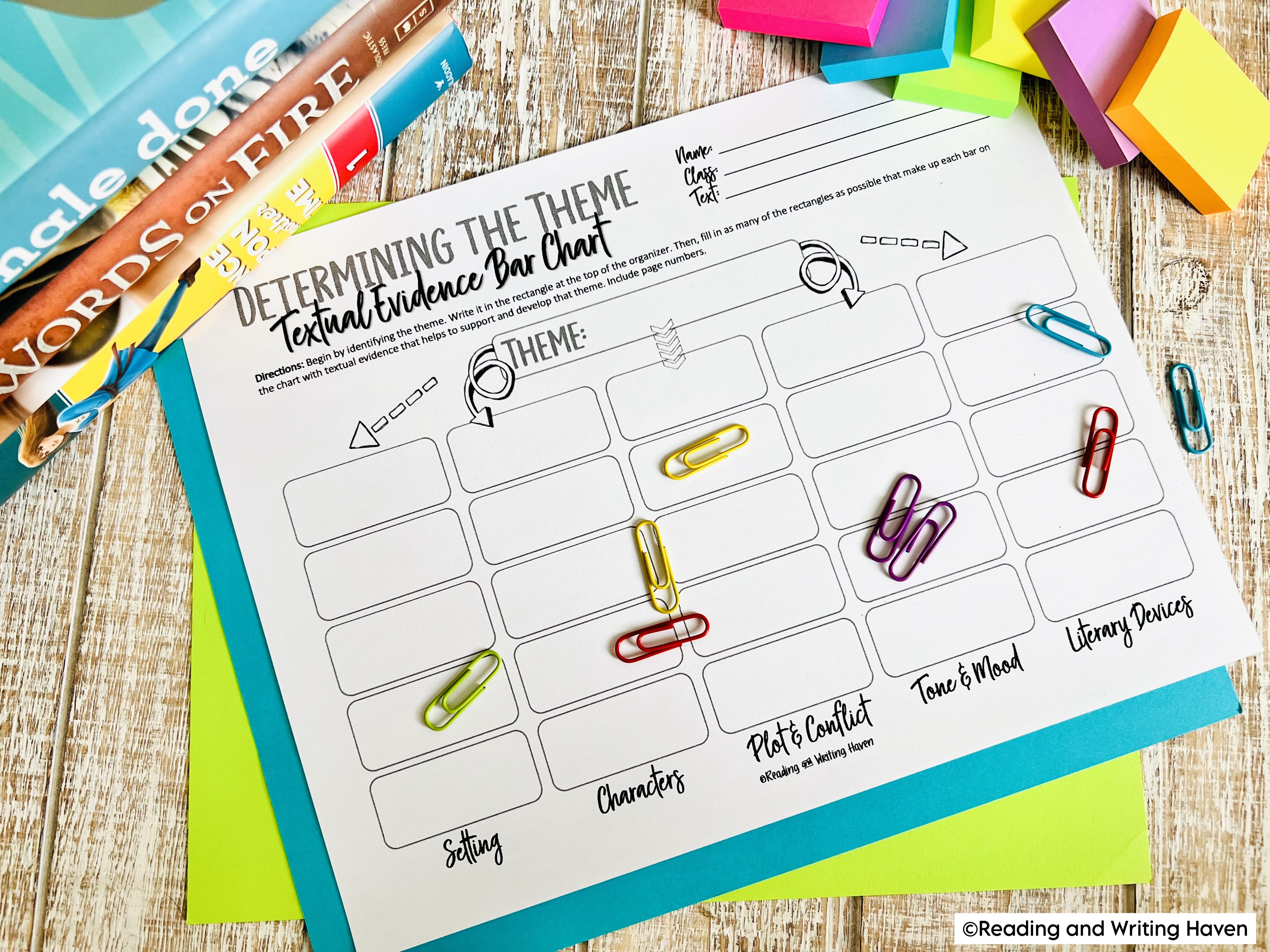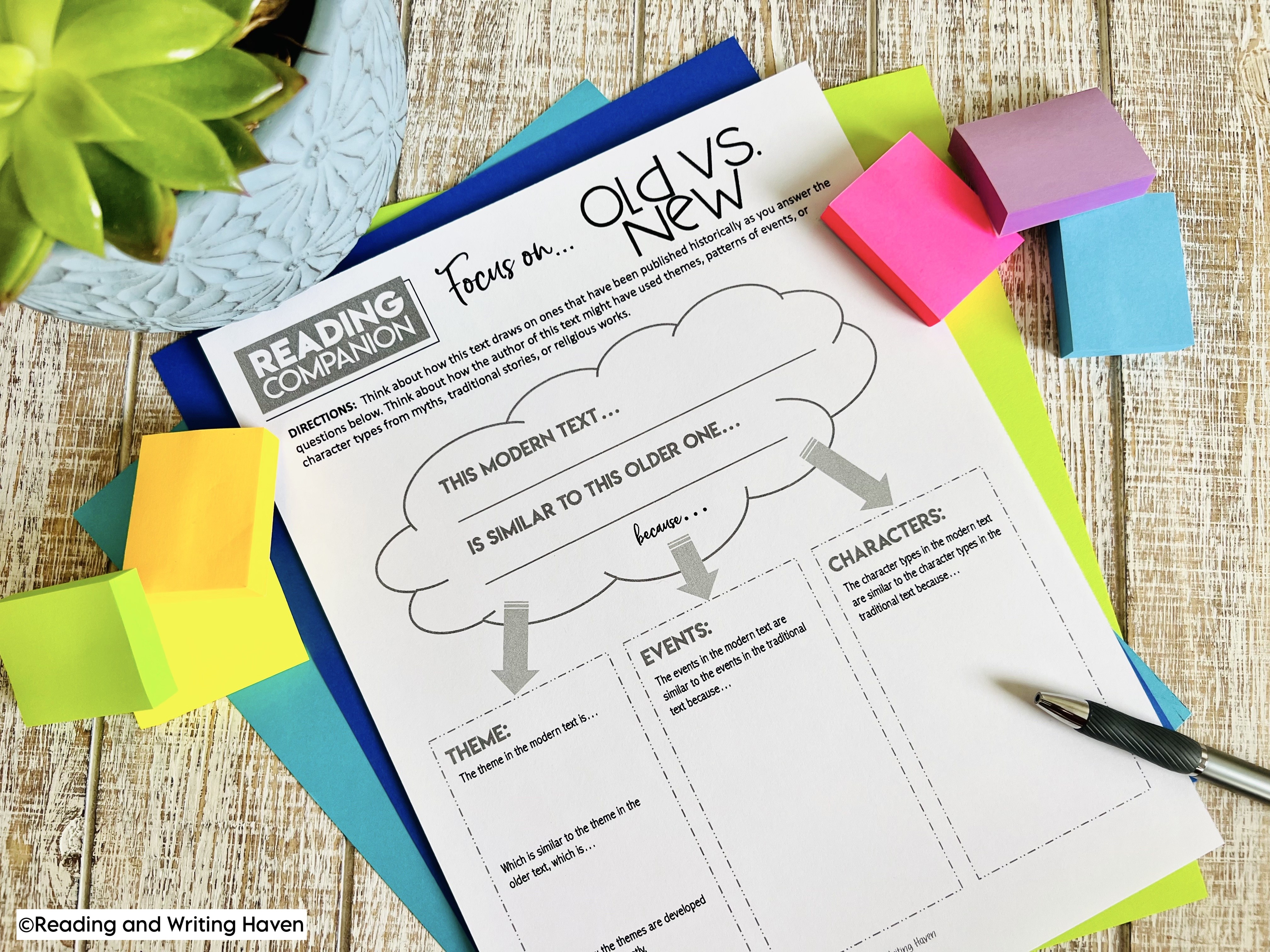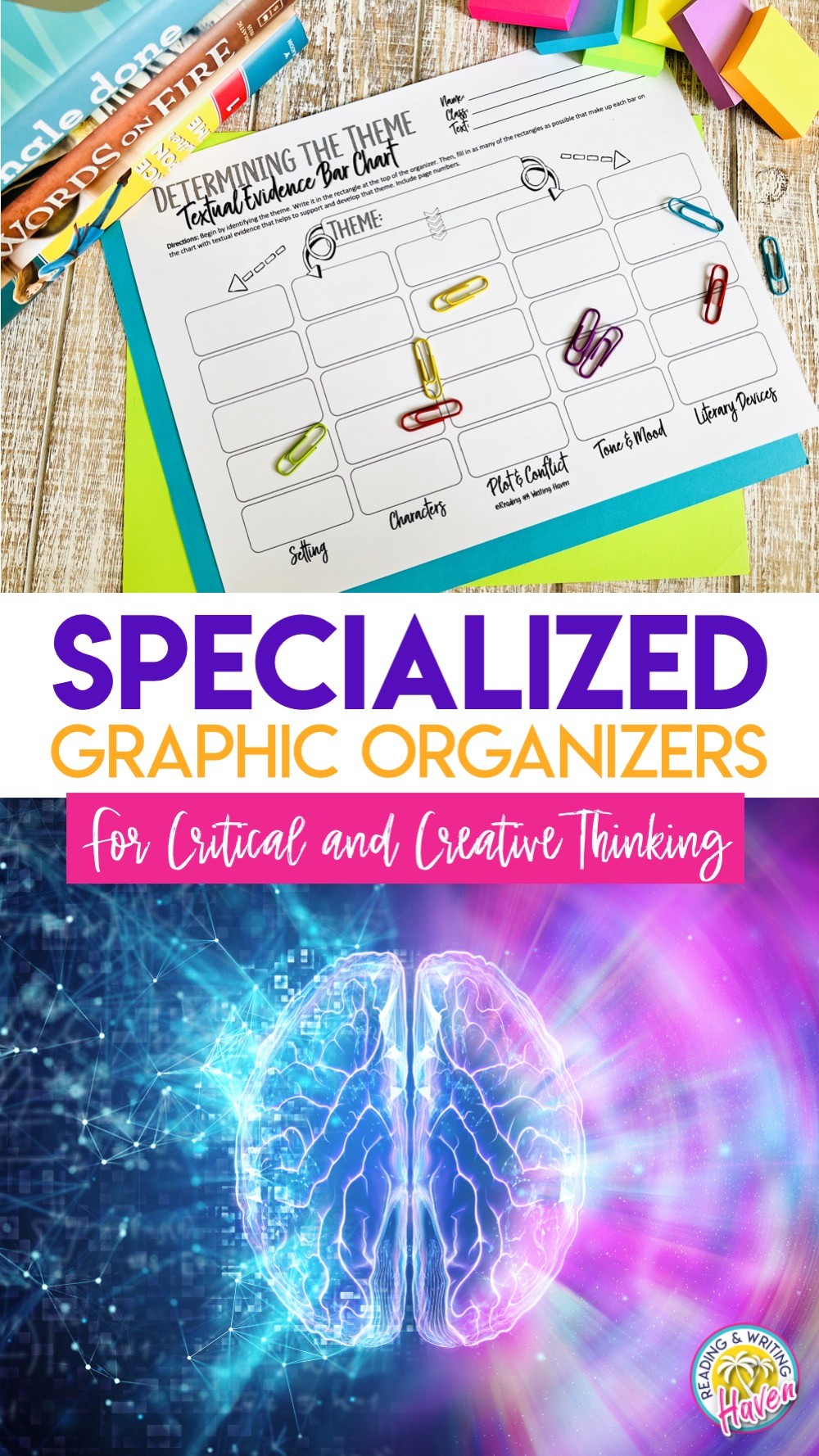How Specialized Graphic Organizers Can Encourage Critical Thinking
Inside this Post: Are your graphic organizers getting stale? Unlock the power of specialized graphic organizers, and watch critical thinking soar. (I’ll also be speaking about this topic at a free professional development session this summer. Claim your seat here!)
I don’t know about you, but one of my favorite things about education is coming up with new and creative ways to teach the standards. I feel reinvigorated when I know that an upcoming lesson includes a fresh activity. And I KNOW that students feel the same way! When they are asked to do the same thing over and over, we start to see unwanted behaviors and lackluster products.
Bland graphic organizers–think KWL charts, Venn diagrams, and timelines–have their place, but can quickly become white noise. Just like colloquial language teens like to use, teaching tools have to evolve to keep students on their toes.
Specialized graphic organizers can be a game changer when it comes to engagement and deeper thinking. When I think about specialized graphic organizers, I think about specific learning targets, purposeful visual appeal, and intentional scaffolding. All of the necessary ingredients that are needed for student success.
If you are looking to level up your graphic organizer game, I have five specific ways you can elevate critical and creative thinking with graphic organizers. Along the way, I will share some specialized graphic organizers I have created for specific learning goals.
WAY #1: Go beyond basic recall.
Are your students becoming reliant on AI? Our students are surrounded by more and more technology everyday, so it is increasingly important that we offer students opportunities to elevate the ways in which they think about the information they access. What features can you add to your graphic organizer that will increase the level of thinking required from students?
Does your organizer…
-
- encourage categorizing of information?
- cause connections between content?
- achieve broader understandings?
- prompt students to ask further questions?
How might a lack of critical and creative thinking look? Let’s get specific.
If your students are giving one-word responses without textual evidence when you ask them to describe a text’s structure, it may be time to teach students to move past basic recall. Take students from simply identifying a text structure and lead them towards discussing the overall impact of a sentence or part of a text.
In the specialized organizer above, students select one sentence from the text and explain why it is important, what it relates to, how it functions, and more! Gone are the days of copying and pasting the “right answer.” This is how we help students develop the ever-important skills they need. Think…analysis, synthesis, and evaluation.
Take that, ChatGPT!
WAY #2: Use sentence frames or sentence stems.
Just like when we talk about modeling how to complete graphic organizers, we have to continuously model how to write standards-aligned responses. Sometimes extra scaffolding is necessary to make sure that everyone can access the higher-level thinking tasks.
Sentence stems or frames can force complex thinking when students may not otherwise be ready. It might feel like giving away the answer, but I promise that it’s not! Sometimes we all just need a jumping off point to get us started.
Even better yet, we can build student autonomy by offering choices when it comes to sentence frames or stems. Just like training wheels, we should encourage students to use what they need until they don’t need it anymore.
I can’t even begin to tell you how many times I have asked a student to describe a character from a text and their response is “They are nice.” or “They are smart.” It’s like every vocabulary word or character trait we’ve discussed is nowhere to be found!
Analyzing characters requires students to think about so many different things, but it can quickly become overwhelming and lead to short, boring responses. And, short, boring responses typically mean less thinking and learning.
A solution? Elevate critical thinking by encouraging students to think about all of the various aspects of characterization. In the graphic organizer pictured above, notice how I ask students to make an inference about the character, and I give them an extra sentence starter to remind them to use text evidence. Now I am not repeating myself a million times, and students are working independently AND at a high-level. It’s a win-win!
WAY #3: Discuss conceptual relationships.
Thinking critically means making connections, looking for patterns, and analyzing relationships. Graphic organizers should help students do just that. But, are students paying attention to the relationships of concepts on their organizers? Or do they just see isolated topics? Do students understand how the components on the page work together to help them achieve the larger learning target?
Explicitly walking students through a graphic organizer and pointing out how the pieces connect or work together can elevate critical thinking. For example, you can teach students to use text structure to identify main ideas and supporting details.
Have students read 3-5 brief passages with the same main idea, but different text structures. Provide them with a graphic organizer with places to analyze the text structure of each passage. Finally, have students look for patterns in the information they have collected. Show students how the passages are related based on the topic, but how the information they learn changes as the text structure changes.
As another example, when asking students to identify the theme of a story and analyze its development, why not help students categorize the evidence and assess trends in the methods the author uses to develop that theme through the graphic organizer?
Instead of just accepting a brief statement of the theme, ask students to dig deeper into the text to find quotes related to mood, tone, conflict, setting, and literary devices. Show students how these elements work together to develop the theme. Which elements does the author rely most heavily upon? Now they are not only identifying, but they are thinking critically and analyzing.
WAY #4: Deconstruct and then reconstruct learning targets.
When I get to a lesson where it feels like I’m pulling teeth, I always go back to the basics to see if there are skills that students need to (re)learn in order to move forward. I deconstruct the learning targets for students, so they can fully understand each piece of the puzzle. Graphic organizers are intended to help students deconstruct information. But we cannot stop there. We must help students connect the pieces they have deconstructed to elevate the level of thinking required. I like to call this “packing it back up.”
Take analyzing the plot to determine the theme, for example. Do students spend the majority of their time identifying the plot elements? If so, they are probably not doing much heavy lifting. Being able to name the characters and sequence the plot is important, but it isn’t enough. Students need to be analyzing how those elements shape the theme. If they are using an organizer that unpacks the learning targets, but never packs them back up, they aren’t going to get very far.
Specialized graphic organizers that are geared toward specific standards can help us achieve our goal.
Comparing texts is a common task assigned to middle and high schoolers.
We can elevate the thinking by asking students to think about how the new text is related to the older text. How might the author have been inspired by the themes, events, or character types from traditional, or older, texts? The graphic organizer pictured above breaks down the learning target by asking students for evidence from the old and new texts to support themes, events, and characters.
Built-in scaffolding and review! But, instead of stopping there, students continue by thinking critically about how these topics relate to each other AND how they inspired new texts. Everything is tied back together at the end–critical thinking has occurred!
WAY #5: Expect students to articulate the goal.
Knowing “why” you are doing something should always be our first step! The same goes for students–repeatedly asking students to explain what they are doing and why they are doing it keeps them accountable for their learning.
Students can articulate their learning in a variety of ways. Consider…weaving the learning target throughout the lesson, assigning exit tickets, conferring with students, discussing with elbow partners, quick checks, reflection activities, and more. Whatever it takes to get kids to think about, write about, and talk about their “why”!
Students often think about filling out a graphic organizer as the end goal. In reality, graphic organizers should be a stepping stone toward more meaningful insights. So, design the graphic organizer with the end goal in mind, and communicate it to your students! Better yet, involve them in the process by asking them what a graphic organizer might need in order to meet a specific learning target or standard.
When students are working on a graphic organizer, we should expect them to be able to answer two questions with confidence and clarity…
- What are you doing?
- Why are you doing it?
If they cannot do this, we have not succeeded. We’ve just given them busy work. And isn’t that what we are trying to avoid?
FINAL THOUGHTS
A highly engaged classroom where students are thinking critically is a truly magical place. The walls hold vibrant anchor charts and visual aids that represent various thinking processes and steps involved in critical analysis. The room buzzes with energy as students eagerly discuss ideas, ask questions, and actively guide their own learning.
At the center of the room, you may find groups of students huddled together collaborating and brainstorming. They sit around tables, armed with graphic organizers that go beyond basic recall, deconstruct and reconstruct learning targets, and make the “why” clear. They use arrows, colors, symbols and sentence frames to show relationships, connect concepts, and evaluate different perspectives. These visuals not only help them understand complex ideas, but also encourage them to think critically, evaluate evidence, and draw reasonable conclusions.
The teacher moves around the classroom, providing guidance and support (never once having to say, “Where is your textual evidence?”) They engage in meaningful conversations with kids, challenging their thinking and posing thought-provoking questions (and getting more than just shrugs in response.) The teacher fosters an environment where mistakes are celebrated and students are encouraged to reflect on their thinking processes. There is joy in the process, and everyone feels it.
While an ideal classroom setting like this may not always be realistic, it should always be our goal to try to get there. Forget rushing through generic graphic organizers to “get them done.” We want students to slow down and savor the learning experience. Specialized graphic organizers and intentional use can help us get there.
_________________________________________
PRO TIP!
Here’s a tried and true strategy I can’t live without! I have a file cabinet (digital and print) of graphic organizers for ANY TEXT – fictional and print. I can’t imagine functioning without this! When we dig down to the heart of a standard, we should be able to use a graphic organizer that targets the student learning goal across texts. Having this “file cabinet” of organizers saves me SO MUCH TIME in lesson planning, learning center creation, and sub plans. Collect your very favorite graphic organizers that work for you, and make them easily accessible. You can grab a bunch of my favorites right in this bundle. Happy teaching!





